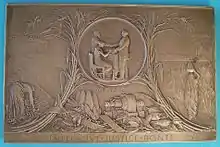Nag Hammadi
Nag Hammadi (/ˌnɑːɡ həˈmɑːdi/ NAHG hə-MAH-dee; Arabic: نجع حمادى Najʿ Ḥammādī) is a city in Upper Egypt. It is located on the west bank of the Nile in the Qena Governorate, about 80 kilometres (50 mi) north-west of Luxor. It had a population of close to 43,000 as of 2007.
Nag Hammadi | |
|---|---|
 Aluminium Stadium in Nag Hammadi | |
 Nag Hammadi Location in Egypt | |
| Coordinates: 26°03′N 32°15′E | |
| Country | |
| Governorate | Qena |
| Population (2007) | |
| • Total | 42,820 |
| Time zone | UTC+2 (EST) |

History
The town of Nag Hammadi was found on the site of older villages Ansan (Arabic: انسان) and al-Luaqi (Arabic: اللواقي)[1] in the 19th century and was named after its founder, Mahmoud Pasha Hammadi, a member of the Hammadi family in Sohag, Egypt. Mahmoud Pasha Hammadi was a major landholder in Sohag, and known for his strong opposition to the British rule in Egypt beginning in 1882.
Nag Hammadi is about 5 kilometres (3.1 mi) west of ancient Chenoboskion (Ancient Greek: Χηνοβόσκιον) The "Nag Hammadi Library", an important collection of 2nd-century Gnostic texts, was found at Jabal al-Ṭārif near Nag Hammadi in 1945.[2]
The city was the site of the Nag Hammadi Massacre in January 2010, in which eight Coptic Christians were shot dead by three men.[3] In total, nineteen Coptic Christians were attacked.[3][4]
Economy
Sugar and aluminium are produced in Nag Hammadi. The Nag Hammadi Sugar factory was built in 1895-1897 by French contractors Cail and Fives.[5] It is still in operation in 2018. Egyptalum is one of the largest aluminium producer in the Middle East. Wood particleboard is manufactured from sugar cane bagasse.
References
- "Carte geographique de l'Egypte et des pays environnans by Pierre Jacotin". PAThs – Archaeological Atlas of Coptic Literature. 1818.
- James M. Robinson (1988). The Nag Hammadi Library. San Francisco: Harper San Francisco.. "The Nag Hammadi Library consists of twelve books, plus eight leaves removed from a thirteenth book in late antiquity and tucked inside the front cover of the sixth. These eight leaves comprise a complete text, an independent treatise taken out of a book of collected essays". (p. 10). "nag-hammadi.com". Archived from the original on 2007-04-08.
- "Egypt's anxious Copts 'await next catastrophe'" (25 January 2010) BBC News
- "Egypt church attack kills Copts". BBC News. 2010-01-07.
- Undated photo Wikimedia